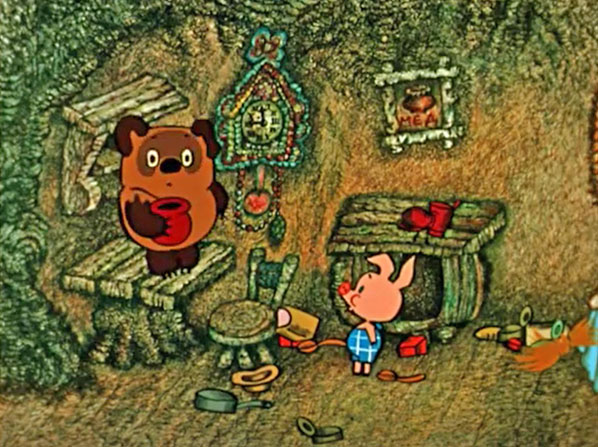
Thanks to Boris Zakhoder and Fyodor Khitruk, a Russian twist on A. A. Milne’s Winnie-the-Pooh made its way into animation film history. Three cartoon shorts, Vinni-Pukh (1969), Vinni-Pukh Idyot v Gosti (1971) and Vinni-Pukh I Den Zabot (1972), were produced out of Soyuzmultfilm Studios.

Fyodor Khitruk
While Boris Zakhoder translated Milne’s Winnie-the-Pooh in Russian introducing the tales for children in the Soviet Union, Khitruk didn’t discover the bear cub from his books. Khitruk’s interest grew from the English editions, and later he paired with Zakhoder for the Soyuzmultfilm series of “Vinni-Pukh” cartoons.
For the most part, it wasn’t a pleasant working relationship. Zakhoder, who was heralded as Russia’s Pooh literary representative, was assigned as a screenwriter. His vision of Pooh was strictly by-the-book. Khitruk was more about transforming the world of Christopher Robin, in fact, without Robin at all.
Khitruk imagined a Pooh environment where stuffed toys didn’t come to life, but living creatures in surroundings a Russian child could relate to. An that is exactly what unfolded.
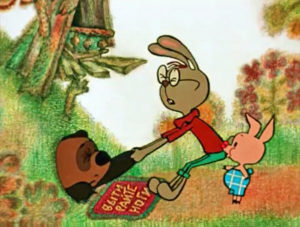 Boris Zakhoder and Fyodor Khitruk sparred often, but Khitruk’s direction was resolute. By the time the third and final Vinni-Pukh cartoon was in production, the two men rarely spoke and communicated via notes delivered to the other by assistants.
Boris Zakhoder and Fyodor Khitruk sparred often, but Khitruk’s direction was resolute. By the time the third and final Vinni-Pukh cartoon was in production, the two men rarely spoke and communicated via notes delivered to the other by assistants.
Tasked with the duties of art directors, Eduard Nazarov and Vladimir Zuykov came up with models for Pooh, Piglet, Eeyore, Rabbit and Owl. Zuykov’s original presentation was virtually rejected, and Nazarov, who had a bit more experience, basically oversaw the artistic aspect. He simplified the design of the cast, and creatively sparred with Khitruk on occasion.
“The form [of Vinni] is simple, but not casual. We talked about it for a long time,” Nazarov stated in an interview. “But playing [around with the design of] Vinni-Pukh was hard enough. We argued.”
Background artists provided an interesting and colorful look, creating illustrations that resembled crayon drawings a child might make that a parent would tape to a refrigerator door. While the style appears amateurish, the depictions of dwellings, in particular, are quite detailed and stand out as imaginative works of art.
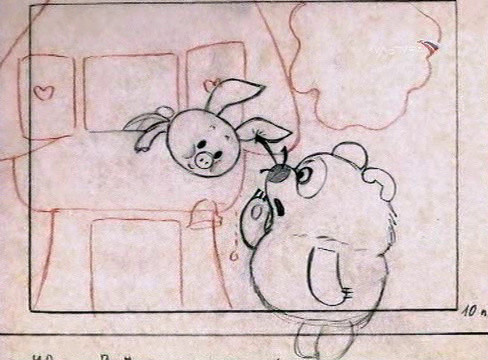
The voice artists brought onboard numbered six. One, Vladimir Osenev, served as the series narrator. As a stage and film actor, didn’t much care for the paying gig. He thought the dialogue written by Zakhoder and Khitruk was “childish” and beneath his talent level. Khitruk stated he “thought of letting him go,” but liked his voice too much.
Disney’s Pooh cartoons had no influence on Khitruk, as he hadn’t seen them. And years later, when he met with Wolfgang Reitherman, director of Disney’s animated Winnie-the-Pooh, Reitherman told Khitruk he liked his version of Pooh better.
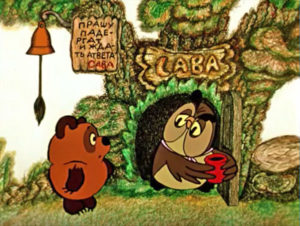 Popular Russian actor Yevgeny Leonov earned the star spot as the voice of Pukh. However, he wasn’t the first choice Khitruk had in mind. He wanted Oleg Pavlovich Tabakov, a popular actor who had appeared in the Soviet film War and Peace.
Popular Russian actor Yevgeny Leonov earned the star spot as the voice of Pukh. However, he wasn’t the first choice Khitruk had in mind. He wanted Oleg Pavlovich Tabakov, a popular actor who had appeared in the Soviet film War and Peace.
But when Leonov recorded his voice audition, Khitruk said, “We realized that we had found our main character.”
Leonov’s voice, like most others cast in roles, were sped up for the final audio tracks.
Iya Savvina provided the voice of Piglet. Anatoliy Shchukin, who recorded the voice for Rabbit, had worked as an animation voice artist for Soyuzmultfilm since 1951. Erast Garin, who provided the voice for Eeyore, came with the biggest professional resume, beginning his acting career in 1917.
 Sadly, Garin was basically a washed-up actor at the time, and took the job. Zinaida Naryshkina became the voice of Owl. She was a comedic actress who had just started working at Soyuzmultfilm as a voice artist.
Sadly, Garin was basically a washed-up actor at the time, and took the job. Zinaida Naryshkina became the voice of Owl. She was a comedic actress who had just started working at Soyuzmultfilm as a voice artist.
Mieczysław Weinberg composed the music for the trilogy, working with Zakhoder, who provided lyrics.
What transpired were the three Vinni-Pukh cartoons, which became incredibly popular with children and their parents in the Soviet Union. The films have also gained worldwide popularity, even though their “unauthorized” status prevented them from entering global competitions when released.
My latest Cartoon Research mini-book, Fyodor Khitruk’s Vinni-Pukh provides an overview of the series production, with all of its ups and downs. But even with their contentious relationship, Zakhoder and Khitruk both knew the series had been something unique and special.
“In general, I have to say that Winnie-the-Pooh was the first time I didn’t curse myself after the end of a film [I] was working on,” Khitruk stated later in life.











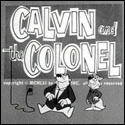





























I’m a big fan of this adaptation. I’ll check that book, of course.
I like both takes on that silly old bear
This is a dumb question, but how come this Pooh’s feet aren’t connected to his body when he walks?
There’s no room for legs that would move the impossible stride lengths from that distance from his torso so its better not to give him any legs. Also, when he stands up on his feet there’s no room for legs. Plus it goes well with him talking while he walks. It’s not just the legs that are unusual though. Since Pukh doesn’t have clearly rendered shoulders he can stretch his arms further towards his front or his back. I can only gather my impressions by watching it though. It may be discussed in some archived materials at Soyuzmultfilm or his estate but I don’t know since I’m not a Russian speaker and have never been to the country. If somebody has an alternative, better explanation then please correct me.
I love to see what artwork is included in the book!
As a Russian who grew up with this cartoon and who still loves its sense of humor and animation style, thanks for providing interesting information about it.
I love Russian animation (movies in particular) the details and textures not to mention their stories. The way they use rotoscoping…its like a beautiful dream. I wish they were released here (U.S.) on Blu-ray especially their live action versions of their animated films. Mr. Collier thanks for mentioning this delightful series. I just checked too see if it’s on YouTube and it is lol. So charming!
Beautiful article. After watching Kithruk’s adaptation, it’s hard to go back to the Disney one. Do you have plans for a kindle version? It’s interesting for anyone outside the U.S.